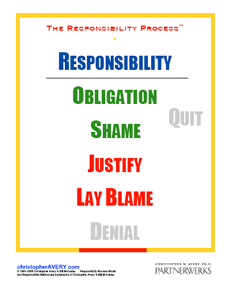Challenge Your Personal Agility
Friday, 26 September 2008
‘To some, responsibility is a burden. To others, responsibility is a reward. For many, responsibility means having someone to point to.’
– Christopher Avery
It was great to finally meet Christopher Avery at the Agile Business Conference this Wednesday. His presentation on the Responsibility Model, delivered in person, was every bit as insightful and entertaining as I hoped it would be.
‘Humans are born to learn’
According to Christopher, Responsibility has long been considered as a character trait. Or, depending on your view of the world, a character flaw.
Newsflash: Responsibility is neither a character trait nor flaw. Christopher describes Responsibility as the way you respond to a problem. Responsibility is completely subjective. It’s also a feeling. This is why Responsibility is so difficult to talk about.
For me, the most effective way of thinking about Responsibility is to compare it with Accountability. According to Christopher, delegating Accountability is the first tool of management. It’s a one-sided agreement-making process in which one individual beholdens another regardless of whether or not that individual accepts the responsibility that has been thrust upon them.
Responsibility, on the other hand, empowers an individual by giving each of us the choice to acknowledge then embrace the uncertainty surrounding our lives and to do something about it.
Redefining Responsibility
There are six progressive phases in the Responsibility Model:
-
Denial – ‘Problem? What problem? There’s no problem.’
-
Blame – ‘I don’t have a problem working with you. You seem to have a problem with me. That makes it your problem. ‘
-
Justify – ‘I guess it’s possible that I’ve become insensitive to other people’s feelings and needs. I can’t help it though. After all, I’ve been doing this job for a long time. It’s who I am.’
-
Shame – ‘What have I done? I’m going to look such an idiot in front of the people at work. How am I going to live it down? Why should they help me after the way I’ve behaved?’
-
Obligation – ‘Tell me what you think I should do. I have no choice but to do it (even though I don’t want to). I’ll do whatever you say. It’s only a job after all (no one can expect to do a job they love).’
-
Responsibility – ‘I can wait for them to change but that could take forever. No, it’s up to me. I want to fix the problem. So how am I going to be a better colleague? I know! I’ll listen more. And be more considerate towards others. It’s a start.’
Taboo Who?
Embrace responsibility. Instead of skirting around it, talk about it. Practice moving through the 6 phases of the Responsibility Model. Help each other spot when one of you become stuck in a particular phase. The key to continuous improvement are what Christopher has identified as the Keys of Responsibility.
The Keys of Responsibility
1. Intention – Commit to doing or stop doing something.
2. Awareness – Learn to recognise when you are in each of the 6 phases. Look out for how you feel in each of those phases. Use the feeling to help you recognise which phase you’re in and evaluate why you feel that way you so that you can move onto the next phase towards Responsibility.
3. Confront – Face the truth head on. It’s sounds simple, but it’s not easy. How honest are you with yourself?


No. 1 — September 27th, 2008 at 4:28 pm
[…] His model explains how we typically react in the face of problems. Portia has a good writeup of the material. On the way back Portia and I had a lot of fun going through each of the steps in the model in an […]
No. 2 — October 2nd, 2008 at 11:40 pm
Hi Portia, thanks for the excellent write-up on my talk about Responsibility Redefined™. I think you show a pretty good understanding of it. I hope you get a few readers from my post about our meeting: http://www.christopheravery.com/blog/agile-over-the-sea/
No. 3 — November 4th, 2008 at 3:03 am
[…] is the way we respond to a problem. Responsibility isn’t given; it’s taken. Taking responsibility means we make the choice to do something about the problem. Responsibility […]
No. 4 — November 9th, 2008 at 7:34 pm
[…] Coach: Blaming is much easier, isn’t it? Is there more to being […]
No. 5 — April 25th, 2009 at 11:04 pm
[…] change fluidly over time. In an agile team, people will take the responsibility for a role as the need […]
No. 6 — June 15th, 2009 at 5:24 pm
Let’s first be clear that “responsibility” and “accountability” are words that do not have generally accepted univocal definitions. We are not finding out what “responsibility” really is but what useful definitions might be attached to the word and what the consequences are of choosing a particular definition.
As a management consultant I find it useful to distinguish responsibility as a person’s feeling of obligation from accountability as an aspect of a relationship which is not one sided but is unequal. Surely someone who signs up to be an employee and who expects to receive a regular salary expects some obligation in return; there is no issue of someone’s having something thrust on them that they did not agree to.
What I generally find works best is that in exchange for saalary the employee agrees to work with full commitment on all tasks assigned by their manager and to give their manager their best advice. The manager, in turn, must consider (but not necessarily accept) the employee’s advice, directs and supports the employee and holds the employee accountable for their work. “Holds accountable” means that the manager judges how well the employee works and levies consequences accordingly – anything from a pat on the back to a promotion to taking training or coaching to, ultimately, firing someone who does not do their job well.
I’m not aware of any taboos around responsibility, but accountability is a topic that management literature avoids. There is an assumption that accountability and hierarchy are evil and inhuman, though when executed well they are liberating. Managers get all kinds of advice on how to persuade employees to do things and employees are encouraged to feel responsible but little is written on what the employee owes the organization in exchange for salary and what the manager needs to do when a subordinate is not delivering what they have agreed to.
The workplace is not a democracy unless it happens to be a partnership. Employees are not citizens of the work organization. Managers I have known do not care if their subordinates deny, blame, justify or feel shame, obligation or responsibility. They want them to do their jobs. They make clear what the job is, support the subordinates and hold them accountable. We are so tied up by political correctness – referring to employees as “associates” let alone avoiding the descriptive term “subordinate” that we have stripped managers of the authority they need to get their work done.
No. 7 — June 20th, 2009 at 4:26 pm
Hi Herb,
Many thanks for sharing your definitions of and views on ‘Responsibility’ and ‘Accountability’.
In my experience, Chris Avery’s definition and approach in redefining ‘Responsibility’ is enlightened, empowering and effective, for both managers and those who are managed.
The strength in the model comes from leveraging two fundamental beliefs: 1) We can’t change other people, we can only change ourselves; 2) People are responsible for their own behaviour and what they do.
No. 8 — August 30th, 2009 at 6:54 pm
[…] thinking. It can be used as an effective thinking tool so long as we live the Agile Values and behave responsibly. As always, the most useful thing to do is look within yourself and change for the better first […]
No. 9 — March 24th, 2010 at 11:43 am
[…] impermanence in life provides a healthy perspective on Now. Instead of being stuck in a perpetual Blame Game, ask yourself ‘What can I do right now to change? How can I make things better (instead of worse) […]